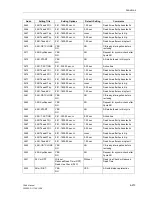
Functions
6-221
7SA6 Manual
C53000-G1176-C156-2
230
Rated Frequency
the operating range of the synchronism check is: rated
frequency ± 3 Hz;
and, if switching at asynchronous system conditions is allowed,
239
T-CB close
the closing time of the circuit breaker.
General
The synchronism and voltage check function can only operate if it was configured as
enabled
during setting of the scope of functions (see Section 5.1, address
135
).
Different close permission (release) conditions can be set for automatic reclosure on
the one hand and for manual closure on the other hand.
The general limit values for closure are set under addresses
3501
to
3508
. Addition-
ally, addresses
3510
to
3519
are relevant for automatic reclosure, addresses
3530
to
3539
are relevant for manual closure.
The complete synchronism and voltage check function is switched Off or On under
address
3501
FCT Synchronism
. The close command is not released when the
function is switched off.
The voltage below which the line or bus-bar is safely regarded as being dead, is set
under address
3502
Dead Volt. Thr.
(for dead-line or dead-bus check). Setting
is applied in volts secondary. When operating the device from a personal computer
using DIGSI
®
4, setting may be in secondary or primary values. Depending on the
connection of the bus-bar voltage (phase–phase or phase–earth) the phase–phase or
the phase–earth voltage is decisive.
The voltage above which the feeder or bus-bar is regarded as being definitely live, is
set under address
3503
Live Volt. Thr.
(for live-line or live-bus check and for
the lower voltage limit of synchronism check). It must be set below the minimum ex-
pected operating voltage under normal conditions. Setting is in volts secondary. When
operating the device from a personal computer using DIGSI
®
4, setting may be in sec-
ondary or primary values. Depending on the connection of the bus-bar voltage
(phase–phase or phase–earth) the phase–phase or the phase–earth voltage is deci-
sive.
The maximum permissible voltage for the operating range of the synchronism and
voltage check function is set under address
3504
Umax
. Setting is in volts secondary.
When operating the device from a personal computer using DIGSI
®
4, setting may be
in secondary or primary values. Depending on the connection of the bus-bar voltage
(phase–phase or phase–earth) the phase–phase or the phase–earth voltage is deci-
sive.
Address
3507
T-SYN. DURATION
determines the period of time, starting from the
measurement request, within which the synchronism check conditions must be ful-
filled. When the conditions are not fulfilled within this time, closing is blocked. When
set to
∞
the conditions will always be checked until they are fulfilled.
If the conditions for synchronous operation must be checked to be maintained for a
certain duration, this minimum duration can be set under address
3508
T SYNC-
STAB
.
Warning!
Incorrect synchronization is possible if the closing time of the circuit breaker is not set
correctly under the general power system data (Power system data 1, see Sub-section
6.1.1, address
239
).
Summary of Contents for siprotec 7SA6
Page 2: ...Siemens Aktiengesellschaft Book No C53000 G1176 C156 2 ...
Page 18: ...xviii 7SA6 Manual C53000 G1176 C156 2 ...
Page 32: ...Introduction 1 14 7SA6 Manual C53000 G1176 C156 2 ...
Page 82: ...Hardware and Connections 2 50 7SA6 Manual C53000 G1176 C156 2 ...
Page 119: ...SIPROTEC 4 Devices 4 25 7SA6 Manual C53000 G1176 C156 2 Figure 4 20 CFC Logic example ...
Page 190: ...Configuration 5 62 7SA6 Manual C53000 G1176 C156 2 ...
Page 652: ...Installation and Commissioning 8 78 7SA6 Manual C53000 G1176 C156 2 ...
Page 724: ...Technical Data 10 56 7SA6 Manual C53000 G1176 C156 ...
Page 800: ...Appendix A 76 7SA6 Manual C53000 G1176 C156 2 ...
Page 866: ...Appendix B 66 7SA6 Manual C53000 G1176 C156 2 ...
















































